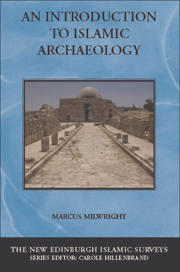Book contents
- Frontmatter
- Contents
- List of figures
- Acknowledgements
- Notes on transliteration and dating
- List of abbreviations
- 1 Introduction
- 2 Early Islam and late antiquity
- 3 New directions in the early Islamic period
- 4 The countryside
- 5 Towns, cities and palaces
- 6 Religious practice in the Islamic world
- 7 Crafts and industry
- 8 Travel and trade
- 9 The ‘post-medieval’ Islamic world
- 10 Conclusion
- Glossary
- Dynasties and periods
- Bibliography
- Index
1 - Introduction
Published online by Cambridge University Press: 05 August 2013
- Frontmatter
- Contents
- List of figures
- Acknowledgements
- Notes on transliteration and dating
- List of abbreviations
- 1 Introduction
- 2 Early Islam and late antiquity
- 3 New directions in the early Islamic period
- 4 The countryside
- 5 Towns, cities and palaces
- 6 Religious practice in the Islamic world
- 7 Crafts and industry
- 8 Travel and trade
- 9 The ‘post-medieval’ Islamic world
- 10 Conclusion
- Glossary
- Dynasties and periods
- Bibliography
- Index
Summary
We dug out a well in the region of the Banu Wurayq. We were unaware of anything (exceptional) existing in it until we noticed the mark of old excavations, which informed us that the place had been dug out at some previous date. Our excavations led us to a huge rock. Turning it over, we found underneath the corpse of a man in a sitting posture and looking so unlike the dead that one would think he was engaged in conversation. Above his head we found the following inscription: ‘I am Qidir ibn Isma‘il ibn Ibrahim, the friend of the Compassionate God. From among a people whose king is unbelieving I fled carrying the torch of the true faith. I testify that there is no god but Allah; I associate none with Him and turn to no other than Him for help.’ Thereupon we restored the place to its former condition.
Attributed to one Salim al-A‘raj, this report is contained within a collection of anecdotes about the antiquities of southern Arabia entitled al-Iklil and written by Hasan ibn Ahmad al-Hamdani (d. 945). In this description of the discovery of a male burial during the digging of a well, the excavators are startled by the pose of the body – standard Muslim practice would require a supine position with the head turned towards the qibla – although the inscription above the dead man's head, with its profession of the oneness of God (shahada), evidently persuades them to leave him undisturbed and, presumably, to sink the well at a different location.
- Type
- Chapter
- Information
- An Introduction to Islamic Archaeology , pp. 1 - 23Publisher: Edinburgh University PressPrint publication year: 2010



